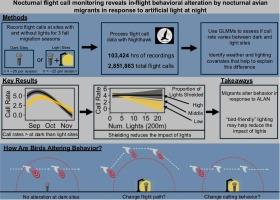夜间飞行呼叫监测揭示了候鸟对夜间人造光的飞行行为改变
IF 4.4
1区 环境科学与生态学
Q1 BIODIVERSITY CONSERVATION
引用次数: 0
摘要
鸟类进化到迁徙的世界在人类世被人造光彻底改变了。城市中心等光源或明亮的向上的灯光吸引移民,改变他们的行为,特别是在恶劣天气期间,往往导致死亡。看似不那么极端的来源,如在世界上大部分地区普遍存在的灯杆式泛光灯,得到的研究相对较少,移民对这些来源的反应也知之甚少。在白沙导弹靶场(美国新墨西哥州),我们通过记录非恶劣天气下有灯光和没有灯光的夜间飞行叫声,研究了候鸟与光线的关系。我们收集了103,424小时的录音,并在三个秋季迁徙季节检测到2,851,863次呼叫。我们评估了时间、天气和光照变量如何解释光照和黑暗地点之间通话率的变化,并研究了不同的分类群体在光照下的表现。与预测相反,在黑暗地点的呼唤率高于光照地点,这种差异在迁徙季节早期最为明显。我们发现,与其他有光的地点相比,有更大比例的屏蔽灯或有更高主导波长(更温暖的色温)的照明地点有更高的通话率(与黑暗地点非常相似),表明这些因素可能会减少对移民的影响。我们的分类学分析显示,莺的鸣叫率在光明和黑暗地点之间存在一致的差异,但大多数麻雀的鸣叫率没有差异。我们的研究结果表明,灯光会改变鸟类的行为,但使用“鸟类友好”的照明策略可能会减少这种影响。本文章由计算机程序翻译,如有差异,请以英文原文为准。

Nocturnal flight call monitoring reveals in-flight behavioral alteration by avian migrants in response to artificial light at night
The world in which birds evolved to migrate has been drastically altered in the Anthropocene by artificial light. Sources of light such as urban centers or bright upward-facing lights attract migrants, altering their behavior, especially during inclement weather, often leading to mortality. Seemingly less extreme sources, such as pole-mounted floodlighting, ubiquitous throughout much of the world, have received comparatively less study, and migrant responses to such sources are poorly understood. We studied migrant behavior in relation to light at White Sands Missile Range (New Mexico, USA) by recording nocturnal flight calls at sites with and without lights during non-inclement weather. We collected 103,424 h of recordings and detected 2,851,863 calls over three fall migration seasons. We assessed how temporal, weather, and lighting variables explain variability in call rates between light and dark sites, and examined how different taxonomic groups behave in relation to light. Contrary to predictions, call rates were higher at dark sites than at light sites, and this difference was strongest early in the migration season. We found illuminated sites with a greater proportion of shielded lights, or with lights of higher dominant wavelengths (warmer color temperatures), had higher call rates (closely resembling dark sites) than other light sites, indicating that these factors may reduce impact to migrants. Our taxonomic analyses revealed consistent differences in call rate between light and dark sites for warblers, but no difference for most sparrows. Our findings indicate that lights alter behavior, but the use of “bird-friendly” lighting strategies may reduce this impact.
求助全文
通过发布文献求助,成功后即可免费获取论文全文。
去求助
来源期刊

Biological Conservation
环境科学-环境科学
CiteScore
10.20
自引率
3.40%
发文量
295
审稿时长
61 days
期刊介绍:
Biological Conservation is an international leading journal in the discipline of conservation biology. The journal publishes articles spanning a diverse range of fields that contribute to the biological, sociological, and economic dimensions of conservation and natural resource management. The primary aim of Biological Conservation is the publication of high-quality papers that advance the science and practice of conservation, or which demonstrate the application of conservation principles for natural resource management and policy. Therefore it will be of interest to a broad international readership.
 求助内容:
求助内容: 应助结果提醒方式:
应助结果提醒方式:


